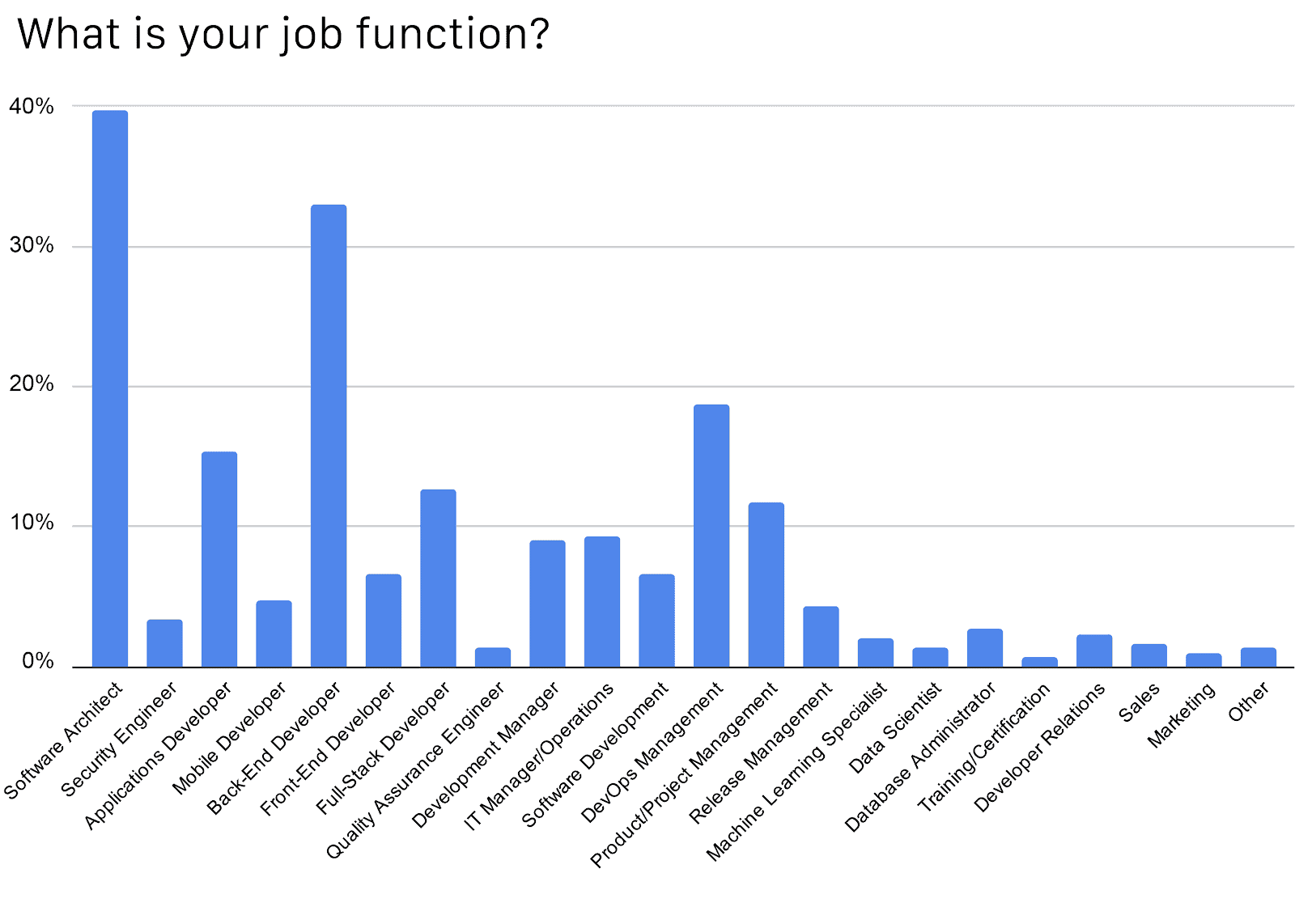Kubernetes is Used in Production by 72% in China
2019 CNCF中国云原生调查 – 中国72%的受访者生产中使用Kubernetes
At CNCF, we regularly survey our community to better understand the adoption of open source and cloud native technologies. For the third time, we conducted the Cloud Native Survey China in Mandarin to gain deeper insights into the pace of cloud native adoption in China, and how that’s empowering developers and transforming development in this large and growing community. This report builds on the first two China reports, published in March 2018 and November 2018.
在CNCF,为更好地了解开源和云原生技术的使用,我们定期调查社区。这是第三次中国云原生调查,以中文进行,以便更深入地了解中国云原生技术采用的步伐及如何在庞大且不断发展的社区中赋能开发者并作出变革。本报告基于2018年3月和2018年11月发布的前两份中国报告。
Key Takeaways of Cloud Native Survey China
- 49% of respondents use containers in production, with another 32% planning to do so. This is a significant increase from November 2018 when only 20% used containers in production.
- 72% of respondents use Kubernetes in production, up from 40% in November 2018.
- The use of public cloud dropped to 36% from 51% in November 2018, replaced by a new option of hybrid with 39%.
- The use of CNCF projects is growing exponentially. CNCF now hosts four projects that were born in China and are more broadly used in the region: Dragonfly and KubeEdge, which are incubating, and Harbor and TiKV, which recently graduated.
The Cloud Native Survey China 2019 included responses from 300 people – 97% of which were in Asia, predominantly in China.
中国云原生调查的重点
●49%的受访者在生产中使用容器,另有32%计划这样做。与2018年11月相比,这是一个显着的增长,当时生产中仅20%使用容器。
●72%的受访者在生产中使用Kubernetes,高于2018年11月的40%。
●公有云的使用率从2018年11月的51%下降到了36%,取而代之的是使用39%的混合新选项。
●CNCF项目呈指数增长。 CNCF现有四个在中国诞生并在该地区更广泛使用的项目:孵化阶段的Dragonfly和KubeEdge,以及刚毕业的Harbor和TiKV。
2019年中国云原生调查包括300名受访对象-其中97%来自亚洲,主要是中国。
Container Usage
We know that containers have transformed cloud-based infrastructures but, over the last year, container use in production has become the norm. According to our global 2019 Cloud Native Survey, which we released earlier this year, 84% of respondents use containers in production, making container use ubiquitous across the globe.
The China survey indicates that while container usage in China lags behind global adoption, it is gaining momentum. Nearly half (49%) of respondents in the China survey use containers in production – a jump from 32% in our March 2018 survey and from 20% in November 2018.
Far fewer members in China plan to use containers in production – 32% versus 57% in our March 2018 survey and 40% in November. This means many organizations have put container plans into action and are no longer in the planning stage. However, there is still room for growth, which we fully expect to continue.
容器使用
我们知道容器已经改变了基于云的基础架构,但是在过去的一年中,容器在生产中的使用已成为常态。根据我们今年初发布的2019全球云原生调查,84%的受访对象在生产中使用容器,使得容器在全球范围内无处不在。
中国调查表明,尽管中国的容器使用落后于全球,但其势头正在增强。在中国调查中,将近一半(49%)的受访对象在生产中使用容器–从2018年3月调查的32%和2018年11月的20%跃升至更高水平。
计划在生产中使用容器的中国会员越来越少-现在32%,2018年3月的调查中为57%,11月为40%。这意味着许多组织已将容器计划付诸实施,而不再处于计划阶段,但仍存在增长空间,希望继续增长。
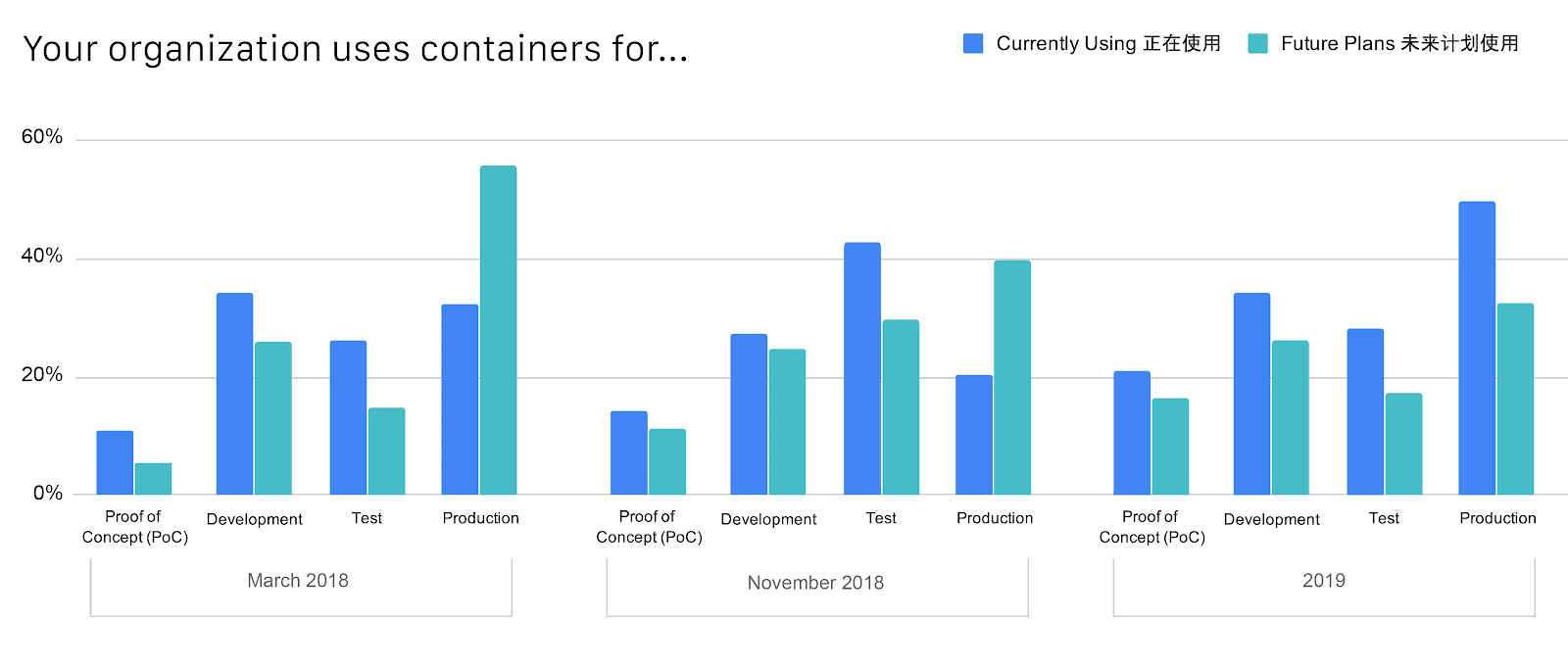
Proof of concept 概念验证
Development 开发
Test测试
Production生产
As use in production grows, the presence of containers in testing environments has dropped. About 28% of China survey respondents are currently using containers in testing – up slightly from 24% in March 2018 but down against 42% in the November 2018 survey.
While containers bring phenomenal advantages, they still pose challenges. These have changed over time, but the challenge of complexity has remained consistent. In the China survey, complexity was named the top challenge by 53% of respondents – compared to 44% in our March 2018 survey, where it was also top, and 28% in November 2018, where it ranked third.
Security ranked second in terms of challenges, with 39% of respondents. It was the first time security was listed as a top challenge. Lack of training and networking tied for third at 36%, while reliability and monitoring were chosen as deployment challenges by 35% of survey respondents.
随着生产中应用的增加,测试环境中容器减少。约28%的中国调查受访者目前测试中使用容器-与2018年3月的24%相比略有上升,但与2018年11月的调查中的42%相比有所下降。
尽管容器带来了惊人的优势,但也带来了挑战。随着时间的推移发生了变化,但是复杂性的挑战一直保持不变。在中国调查中,53%的受访者将复杂性列为最大挑战。 相比之下,2018年3月的调查中, 44%受访者认为复杂性是最大挑战,占比最高。2018年11月的调查中28%的受访者,占比排第三。
在挑战方面,安全性排名第二,受访者占比39%。安全首次被列为首要挑战。培训不足和网络并列第三,占比36%,而35%的调查受访者将可靠性和监控性作为部署挑战。
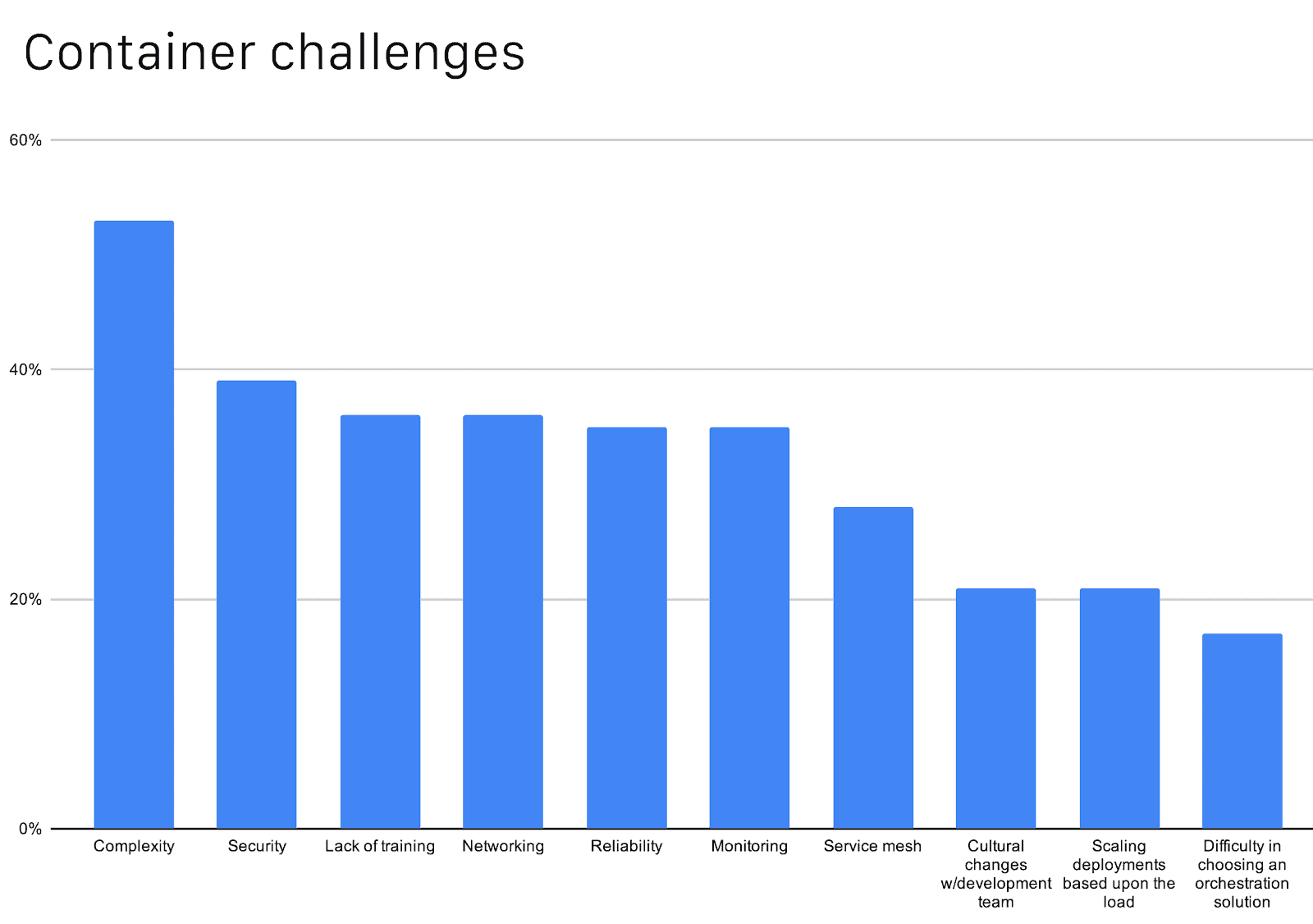
complexity 复杂性
security安全性
lack of training培训不足
networking 网络
reliability可靠性
monitoring监控
service mash服务网络
cultural changes w/development team文化改变w/开发团队
scaling deployments based upon the load基于负载的拓展部署
difficulty in choosing an orchestration solution很难选择编排流程解决方案
Kubernetes Growth
Kubernetes is emerging in the industry as a common platform for container orchestration, and the CNCF community in China has seen a massive spike in adoption. 72% of respondents reported using Kubernetes in production – a dramatic increase from 40% in November 2018.
Consequently, the number of those evaluating Kubernetes has fallen, dropping to 17% from 42%.
Kubernetes增长
Kubernetes作为一个容器编排通用平台正在行业中崭露头角并在中国的CNCF社区中的采用率也急剧上升。 72%的受访者表示在生产中使用Kubernetes-与2018年11月的40%相比有了大幅增长。
因此,评估Kubernetes的人数从42%降至17%。
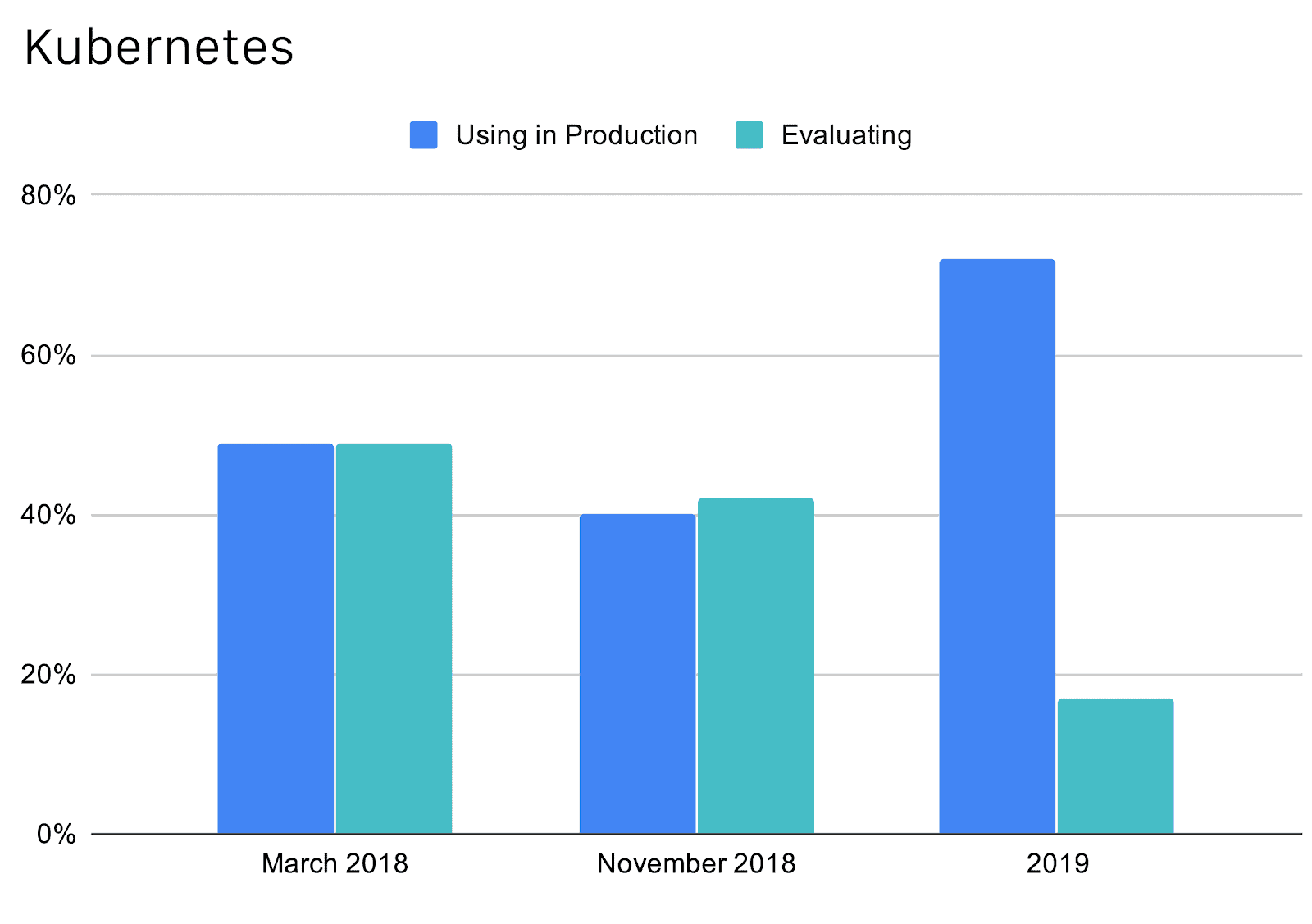
We also see growth in the size of production clusters of Kubernetes at both ends of the deployment spectrum. Most organizations responding to the China survey are using fewer than 10 clusters, but there has been an increase in those running more than 50. This is likely driven by the number of new respondents using containers in production, while those using production containers are adding more clusters.
Thirty-six percent of respondents had two to five clusters, up from 25% in November 2018, with half using between one and five and 70% between one and 10. Just over 13% had more than 50 clusters in production versus 5% in November 2018.
我们还看到Kubernetes的生产集群在部署范围两端的增长。大部分中国调查的受访组织使用不到10个集群,但是运行50个以上的集群的组织有所增加。这可能是由于在生产中使用容器的新受访者数量增加,从而增加了集群。
36%的受访者拥有2到5个集群,高于2018年11月的25%,一半的受访者使用1到5个集群,70%的受访者使用1到10个。只有13%多的受访者生产中有超过50个集群,而在2018年11月时仅有5%的受访者。
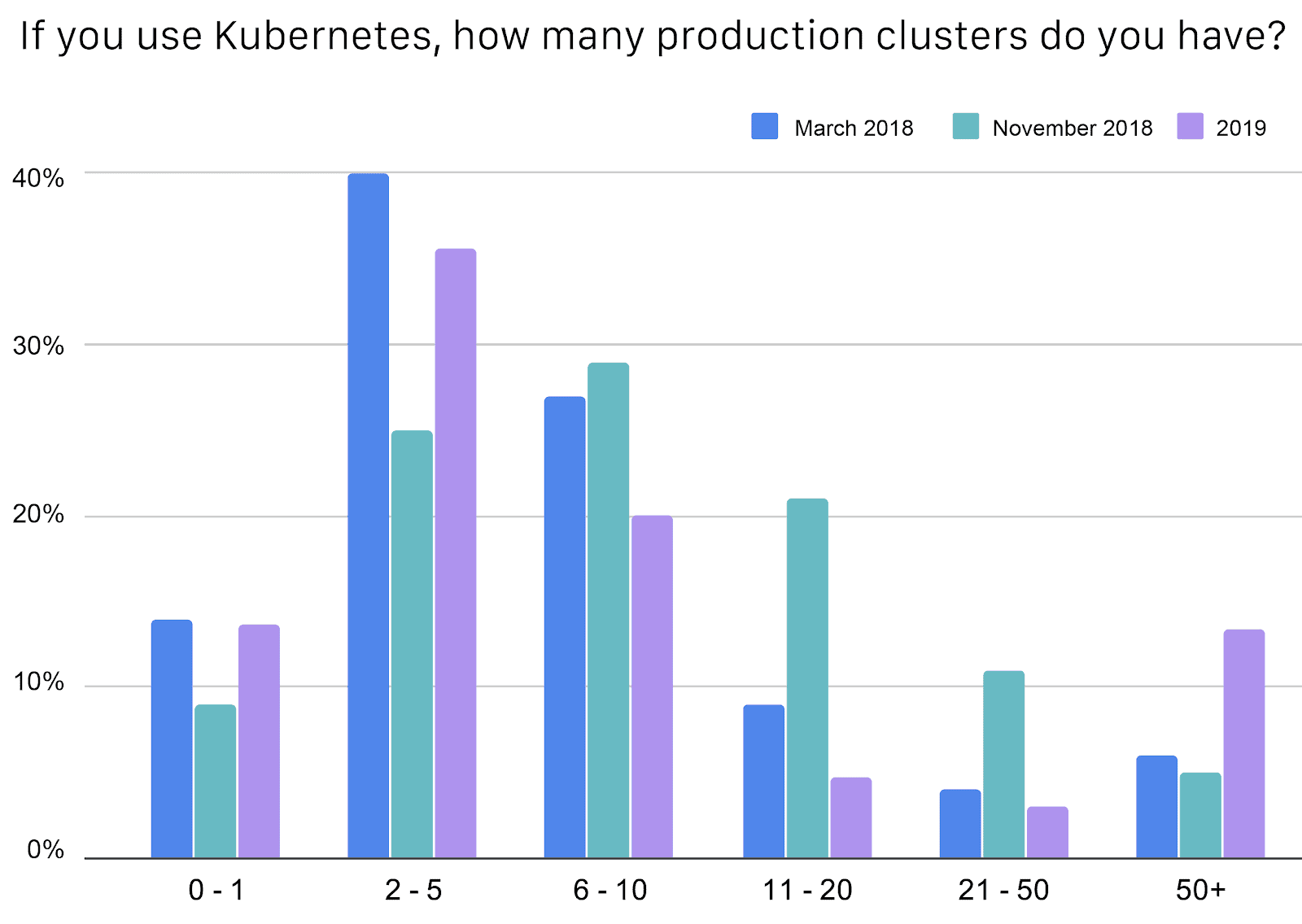
Packaging
Helm is the most popular method of packaging Kubernetes applications, chosen by 54% of respondents.
打包
Helm是打包Kubernetes应用程序最受欢迎的方法,54%的受访者选择了这种方法
Ingress
NGINX (54%) was the most used Kubernetes ingress provider, followed by HAProxy (18%), F5 (16%), and Envoy (15%).
入口
NGINX(54%)是使用最多的Kubernetes入口提供商,其次是HAProxy(18%),F5(16%)和Envoy(15%)。
Separating Kubernetes Applications
Managing objects in a cluster can be a challenge, but namespaces help by filtering and controlling them as groups. 71% of respondents separate their Kubernetes applications with namespaces. Of those that use Kubernetes with multiple teams, 68% use namespaces.
分离Kubernetes应用程序
在集群中管理对象是个挑战,但是命名空间通过按组过滤和控制来帮助管理。 71%的受访者用命名空间分离Kubernetes应用程序。在多个团队中使用Kubernetes的调查对象中,有68%使用命名空间。
Monitoring, Logging, and Tracing
It is more common for those using monitoring, logging, and tracing solutions to run on-premise vs. hosted via a remote server. 46% of respondents use monitoring tools on-premise, while 20% run them via a remote service. Fewer respondents use logging and tracing overall, but 26% run tracing on-premise vs. 20% via a remote service. 21% run tracing tools on-premise and another 21% via a remote service.
监控,日志和跟踪
对于那些使用监控,日志和跟踪解决方案的用户来说,本地运行还是通过远程服务器托管更普遍。 46%的受访者使用本地监控工具,而20%的受访者通过远程服务运行。 整体上使用日志和跟踪的受访者较少,但是26%的受访者在本地运行跟踪,而20%通过远程服务运行跟踪。 21%的企业内部运行跟踪工具,另外21%的企业通过远程服务运行。
Code
The speed of development and deployment has accelerated in China thanks to the combined power of cloud and containers, supported by Continuous Integration (CI) and Continuous Delivery (CD). Our survey quantifies development speed by the frequency developers check in code into repositories. Just over a third, 35%, check in code multiple times a day. 43% percent check in code a few times a week, and 16% check in a few times each month.
代码
由于持续集成(CI)和持续交付(CD)的支持,云和容器的强大功能共同推动了中国的开发和部署速度。 我们的调查通过开发者将代码检入存储库的频率来量化开发速度。35%的受访对象每天多次检入代码。 43%的每周几次检入代码,16%的每月几次检入代码。
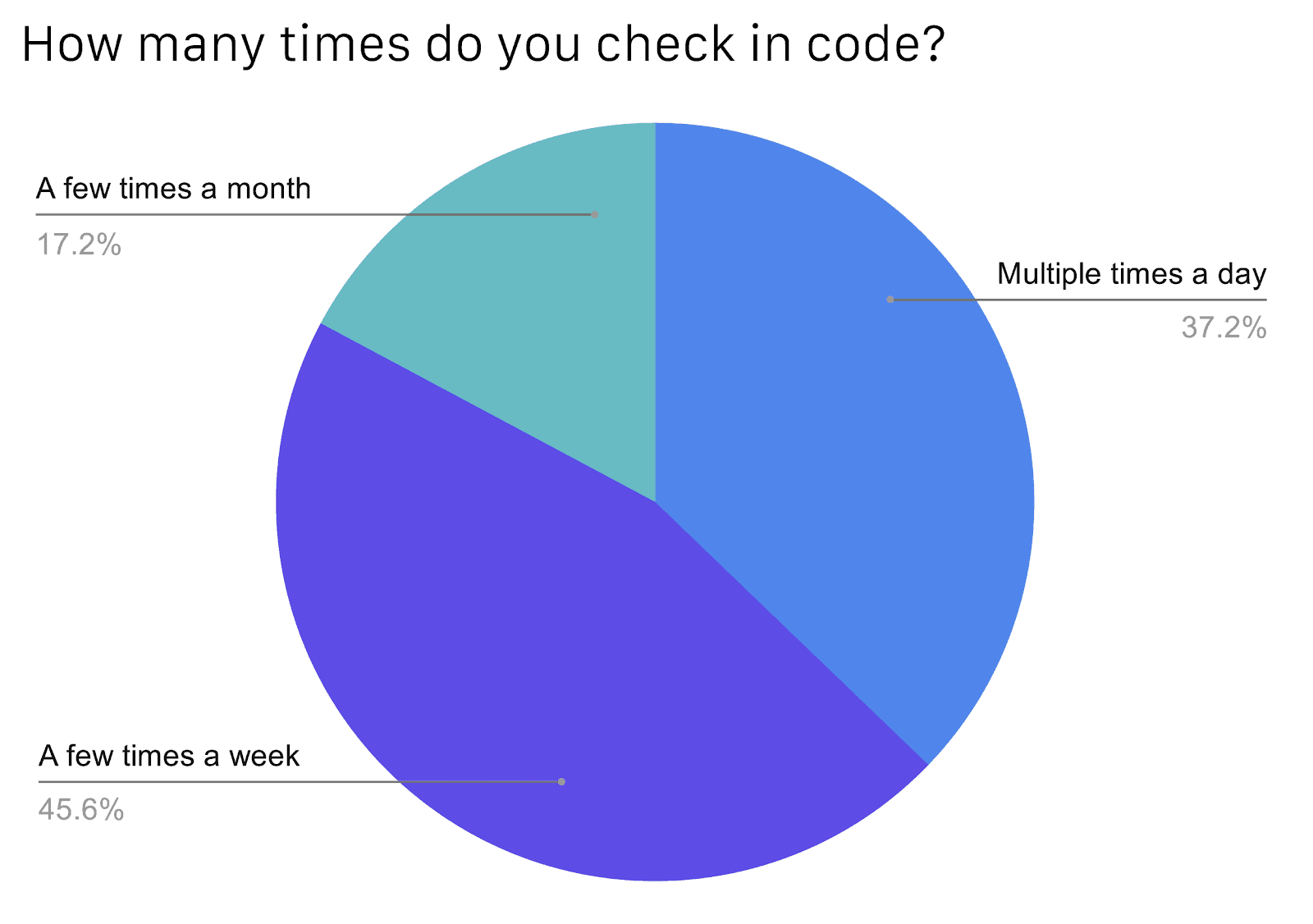
A few times a month 一月几次
Multiple times a day一天几次
A few times a week 一周几次
Most respondents work to weekly release cycles (43%) while just over a fifth (21%) work on monthly cycles, and 18% on daily cycles. 12% of those surveyed are working to ad-hoc schedules.
大多数受访对象发布周期是每周一次(43%),而仅五分之一多的(21%)是每月一次。而18%的是每日一次。 12%的受访对象按特定时间表工作。
CI/CD
Many consider the foundation of successful CI/CD to be the automation of processes. However, our China survey revealed that purely automated environments are relatively rare – just 21% are employing automatic release cycles, with 31% relying on manual processes. The most popular response was hybrid, with 46%.
许多人认为成功的CI / CD的基础是流程自动化。 但是,我们在中国的调查显示,纯自动化环境相对较少-只有21%的受访对象采用自动发布周期,而31%依靠手动流程。 最受欢迎的是混合方式,占46%。
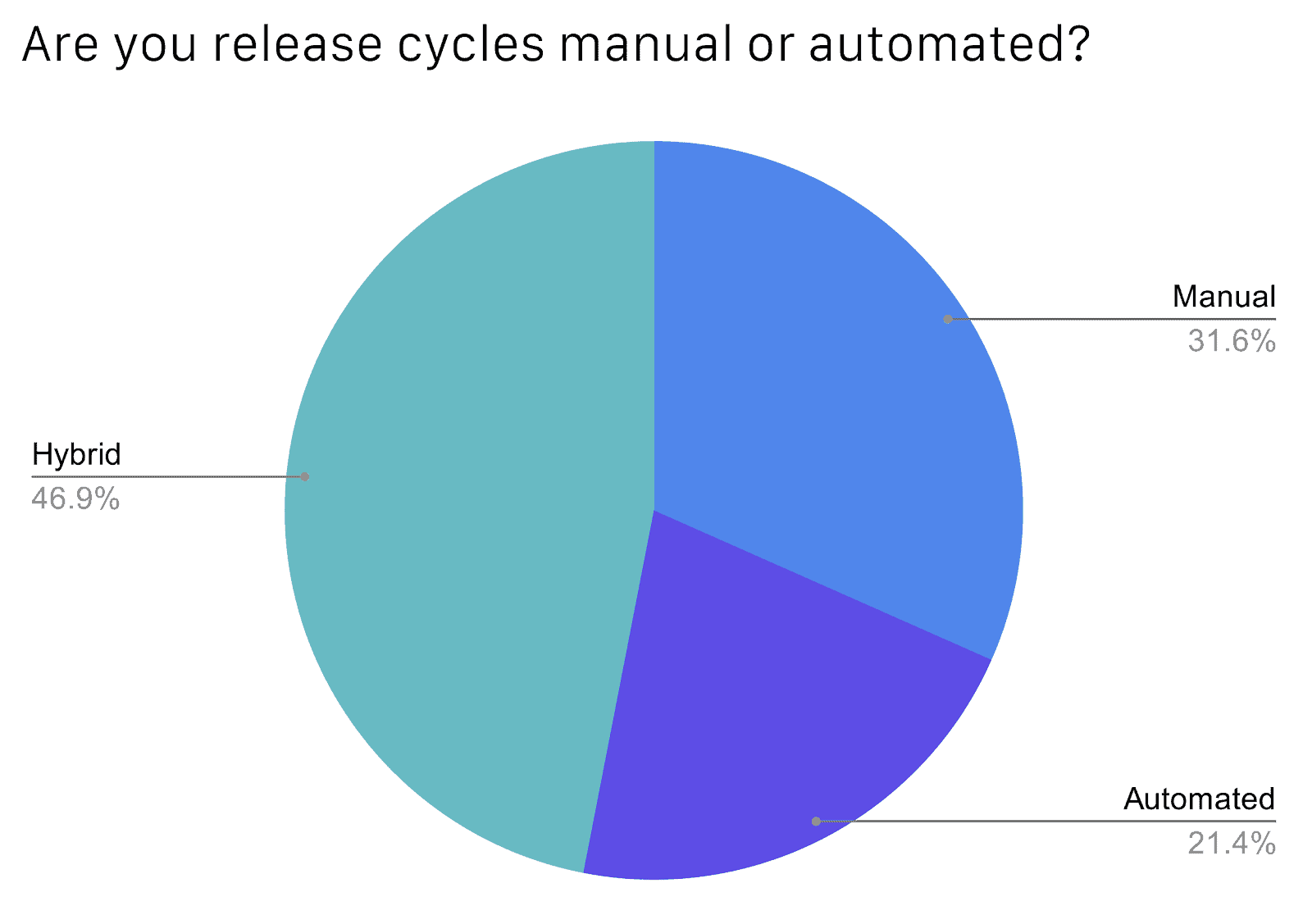
CI/CD is the philosophy and technology that enables agile and flexible delivery and lifecycle management of cloud native systems. The most popular CI/CD tool with the China community, Jenkins, is used by just over half of the community, 53%, and GitLab is used by 40%.
CI / CD是实现云原生系统灵活交付和生命周期管理一种哲学和技术。 Jenkins是中国社区中最受欢迎的CI / CD工具,占社区的一半以上53%,GitLab占40%。
Cloud vs. On-Premise
Cloud is growing, but this year’s China survey revealed a shift away from public cloud, consolidation of private, and the emergence of hybrid cloud. The use of public cloud appears to have peaked in our November 2018 survey at 51%, while this year, it dropped to 36%. Private cloud held steady, 42% versus 43% in November 2018. Hybrid cloud, a new option for this year, emerged at 39%.
云与内部部署
云在增长,但是今年的中国调查显示了从公共云的转移,私有云的合并以及混合云的出现。2018年11月调查中,公共云的使用似乎达到了峰值51%,而今年下降到36%。 私有云保持稳定42%,2018年11月是43%。混合云是今年的新选择,占39%。
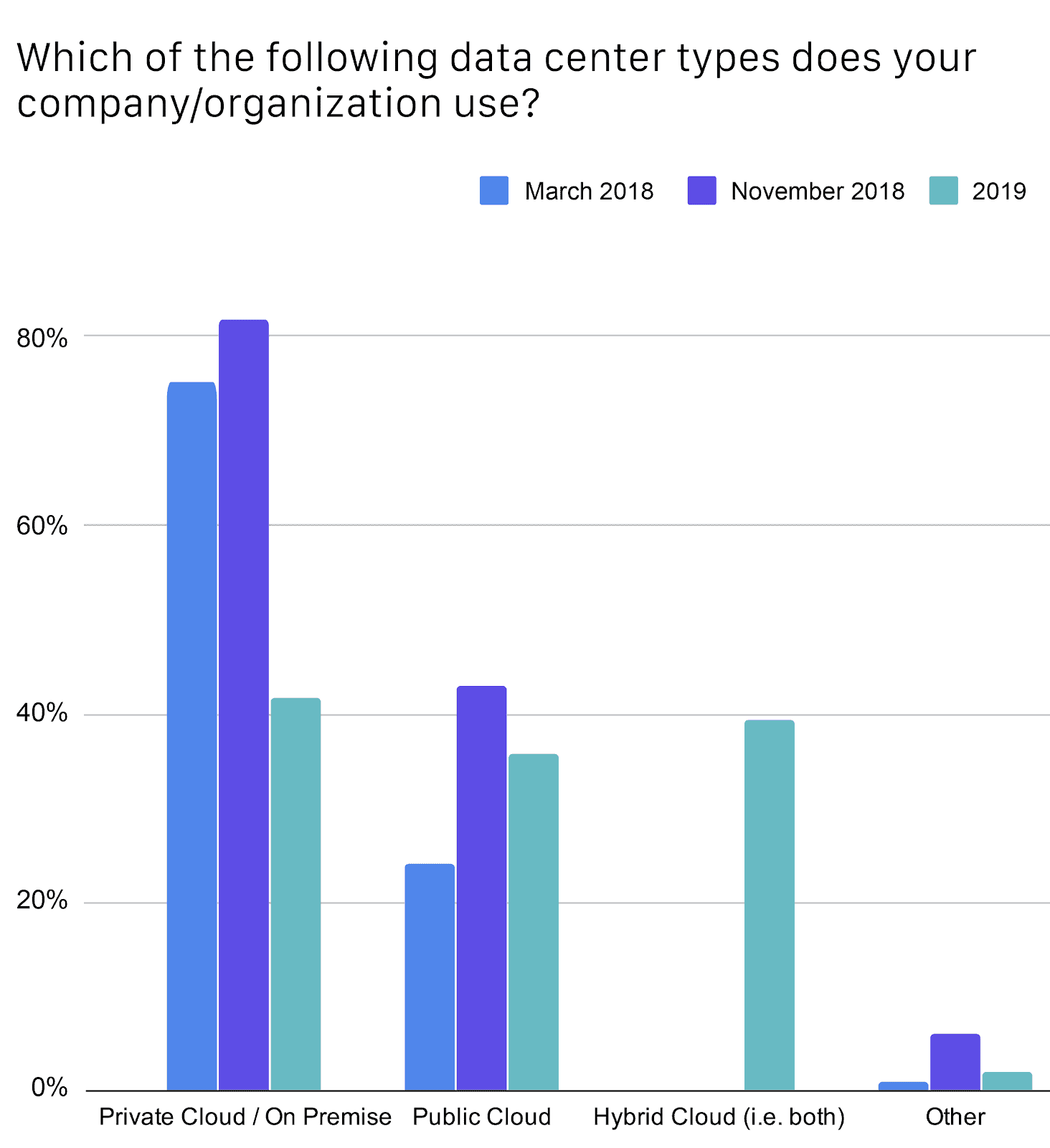
Private cloud私有云
Public cloud公有云
Hybrid cloud混合云
Other 其他
Cloud Native Projects
CNCF stewards a large number of open source projects critical to the development, deployment, and lifecycle management of cloud native. CNCF projects are growing exponentially in China. For example, the Prometheus monitoring and alert system is used by 57% of respondents, up dramatically from 16% in March 2018. CoreDNS is now used by 35%, up from 10% in March 2018. The Containerd runtime has also seen staggering growth – up from 3% in March 2018 to 29% at the start of 2019.
CNCF also hosts four projects created in China that are more broadly used in the region. Dragonfly (17% use in production) and KubeEdge (11% use in production) were two of the most used Sandbox projects. Both are now incubating projects. Harbor and TiKV, which are graduated projects, are used in production by 27% and 5%, respectively.
云原生项目
CNCF管理着大量的开源项目,这些项目对于云原生的开发,部署和生命周期管理至关重要。 CNCF项目在中国呈指数级增长。 例如57%的受访者使用Prometheus监控和警报系统,较2018年3月的16%有显著增长。现在35%受访者使用CoreDNS, 2018年3月只有10%。Containerd运行时也实现了惊人增长 –从2018年3月的3%增长到2019年初的29%。
CNCF还托管了在中国创建的四个项目,这些项目在该地区得到了更广泛的应用。Dragonfly(17%受访者在生产中使用)和KubeEdge(11%受访者在生产中使用)是最常用的两个沙箱项目, 现在两个都在孵化阶段。 Harbor和TiKV是毕业项目,分别有27%和5%受访者用于生产。
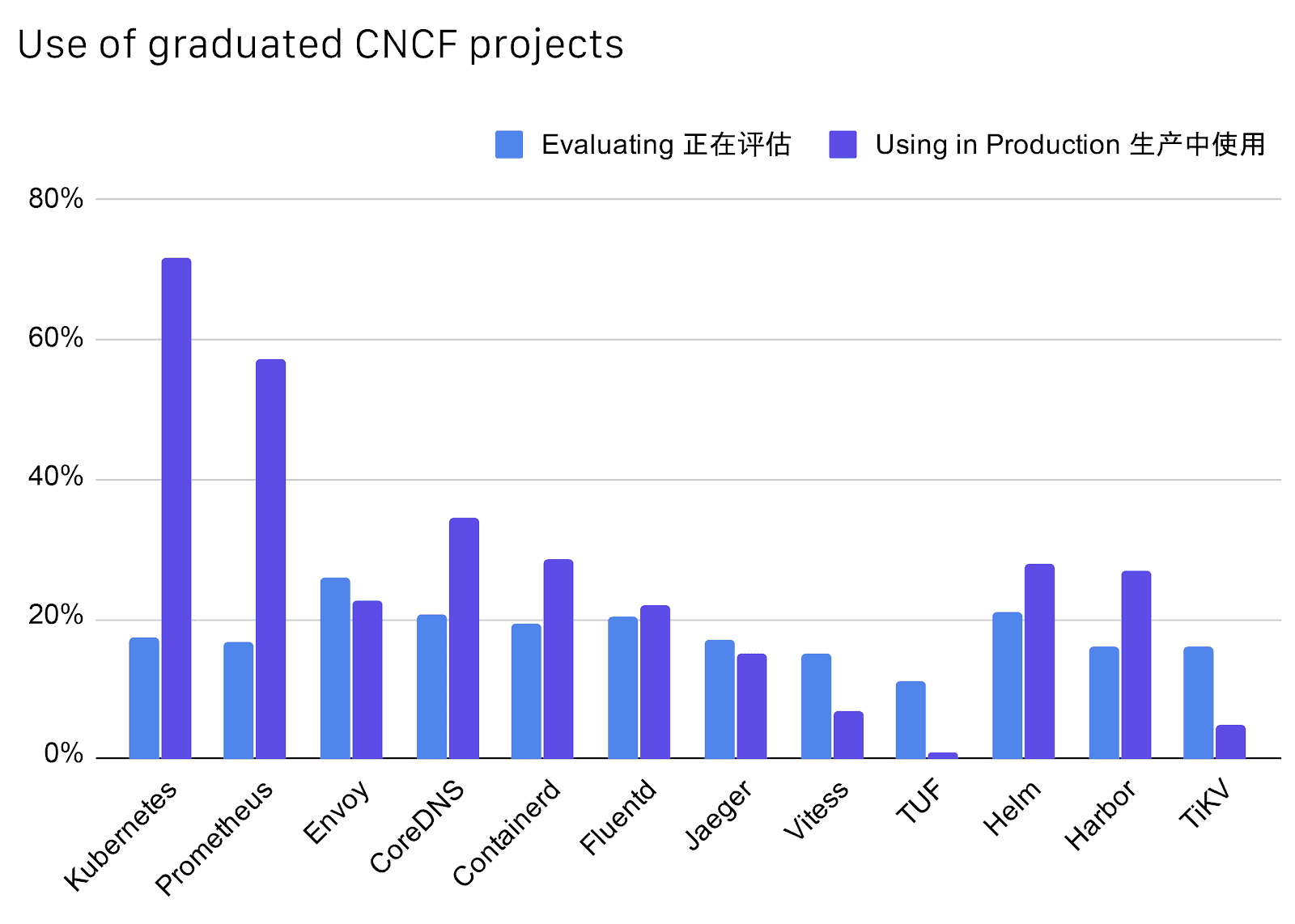
*Not included: Rook, which recently graduated
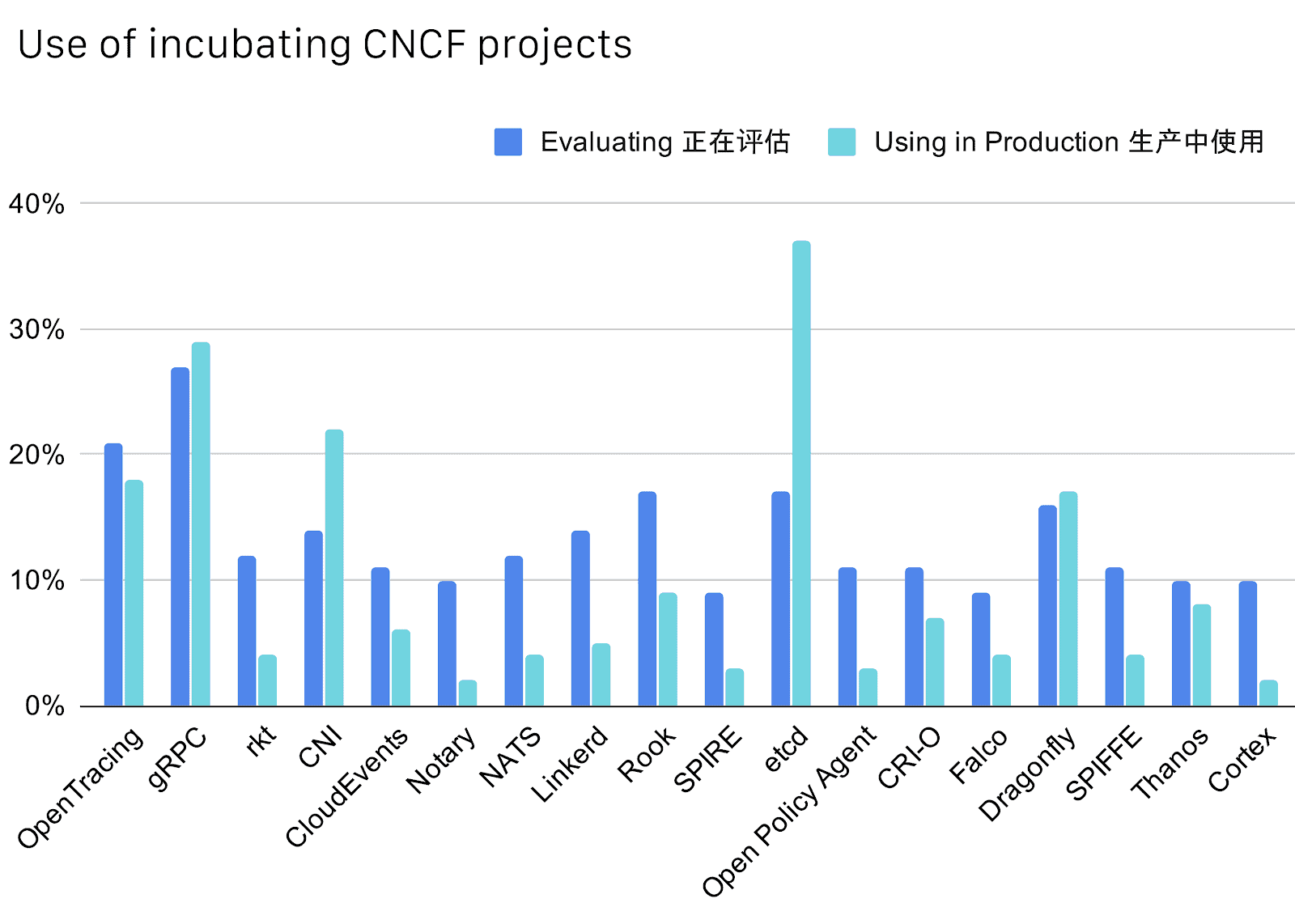
*Not included: New incubating projects Argo, Contour, and Operator Framework. Rook is now a graduated project.
*不包括:新的孵化项目Argo,Contour和Operator Framework
There has been a shift in the perceived benefits of using cloud native projects in production since CNCF’s last China survey:
- Faster deployment times appeared for the first time as the top benefit, cited by 47%.
- Improved scalability retained its earlier, number two position with 35%.
- Cost savings remained third with 33%.
- Improved developer productivity, cloud portability, and improved availability tied for fourth at 31%. In November 2018, availability had been number one and portability number four.
自CNCF上次的中国调查以来,在生产中使用云原生项目的好处发生了转变:
- 更快的部署时间首次成为最大好处,被47%的受访者引用。
- 改进的可扩展性保留其早期的第二名,占35%。
- 成本节省仍然排名第三,为33%。
- 提高开发者生产力,云可移性和更高的可用性并列第四,受访者占31%。2018年11月,可用性排名第一,可移性排名第四。
Serverless 无服务器
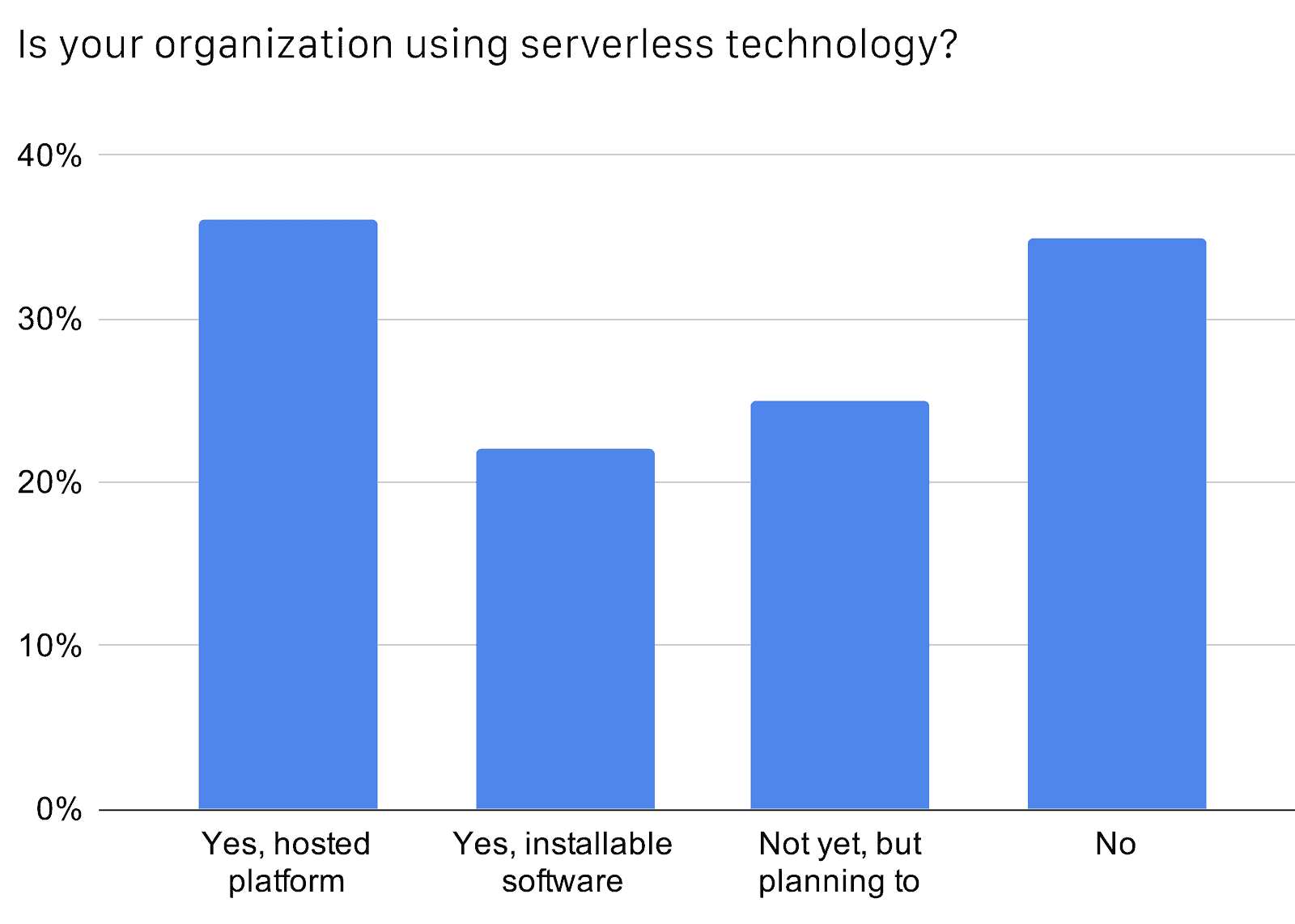
Serverless is being used as a hosted platform by 36% and as installable software by 22% of respondents in the China survey.
在中国的调查中,36%受访者使用托管平台作无服务器,22%使用可安装软件。
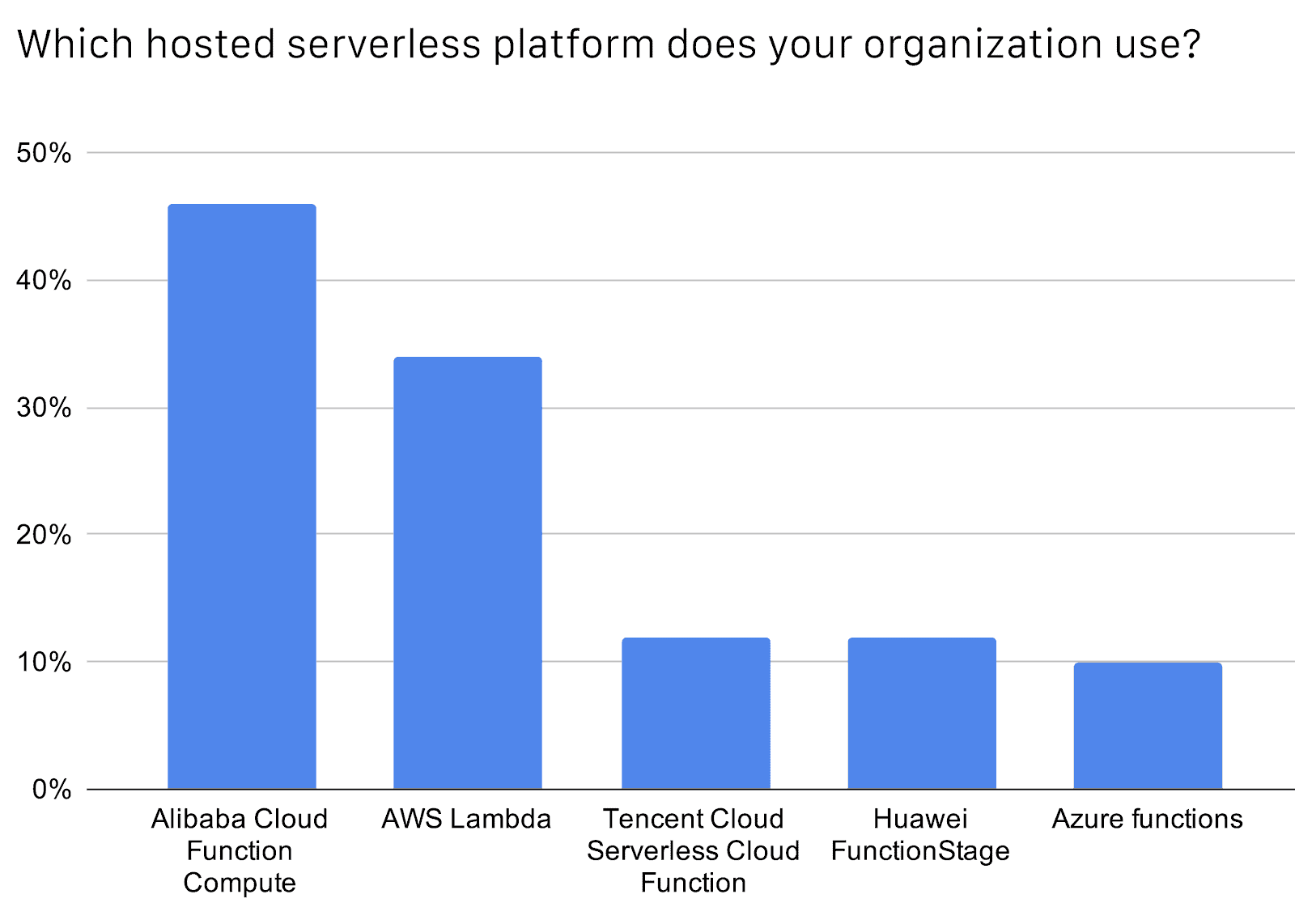
For those using serverless tools as a hosted platform, the top-three providers are Alibaba Cloud Function Compute (46%), AWS Lambda (34%), and a tie between Tencent Cloud Serverless Cloud Function and Huawei FunctionStage (12%).
对于那些使用托管平台作为无服务器工具的企业,排名前三的提供商是阿里云功能计算(46%),AWS Lambda(34%)以及腾讯云无服务器云功能和华为FunctionStage并列(12%)。
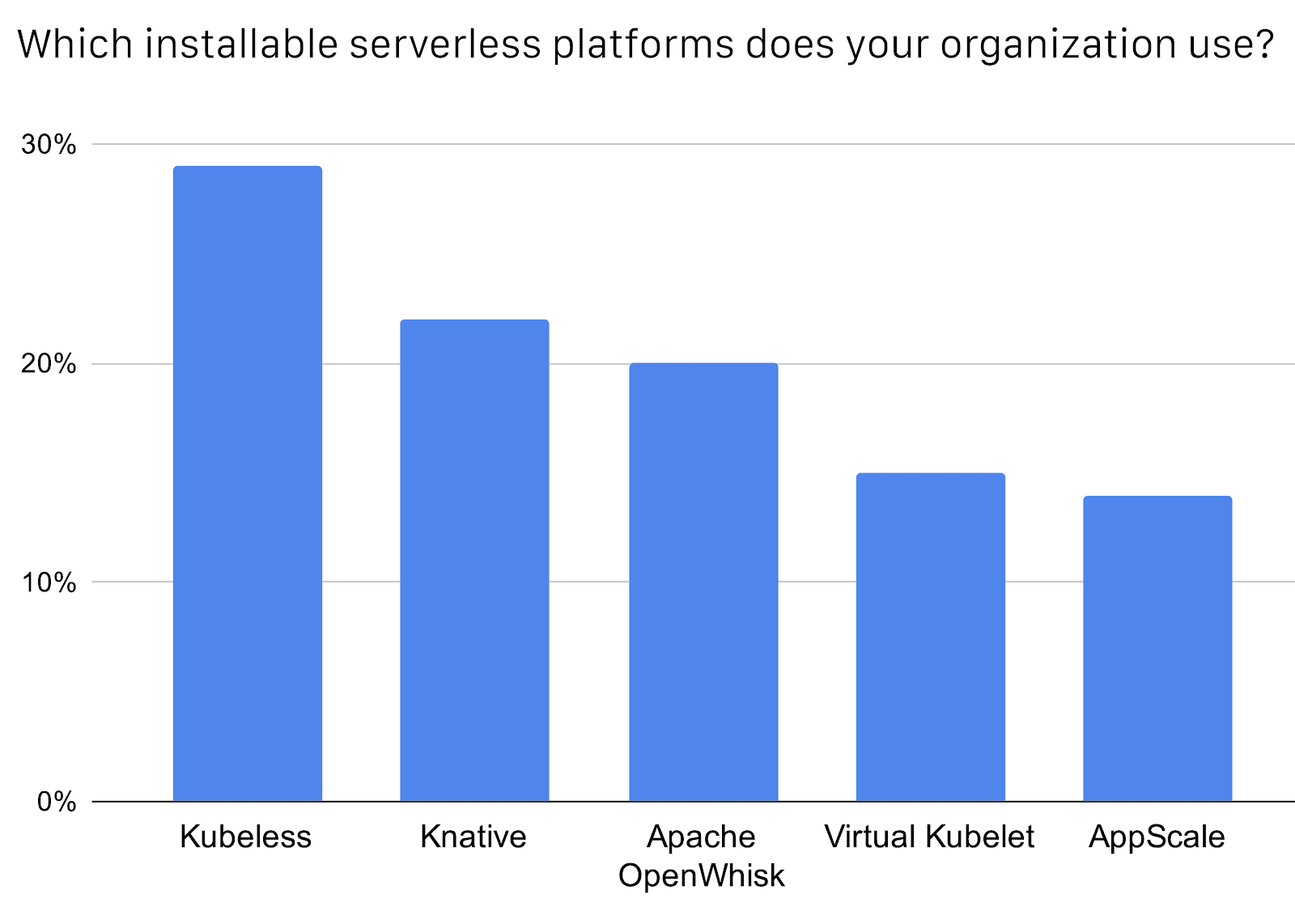
For those using serverless tools as installable software, Kubeless came first at 29%, followed by Knative at 22%, and Apache OpenWhisk at 20%.
For 2019 we added new questions on cloud native storage and service mesh. These are the popular cloud native projects underpinning these benefits in active production environments:
对于那些使用可安装软件作为无服务器工具的用户,Kubeless排名第一(29%),其次是Knative(22%),以及Apache OpenWhisk(20%)。
2019年,我们在云原生存储和服务网络上增加了新问题。这些是流行的云原生项目,可在活跃生产环境中支撑这些优势:
Storage 存储
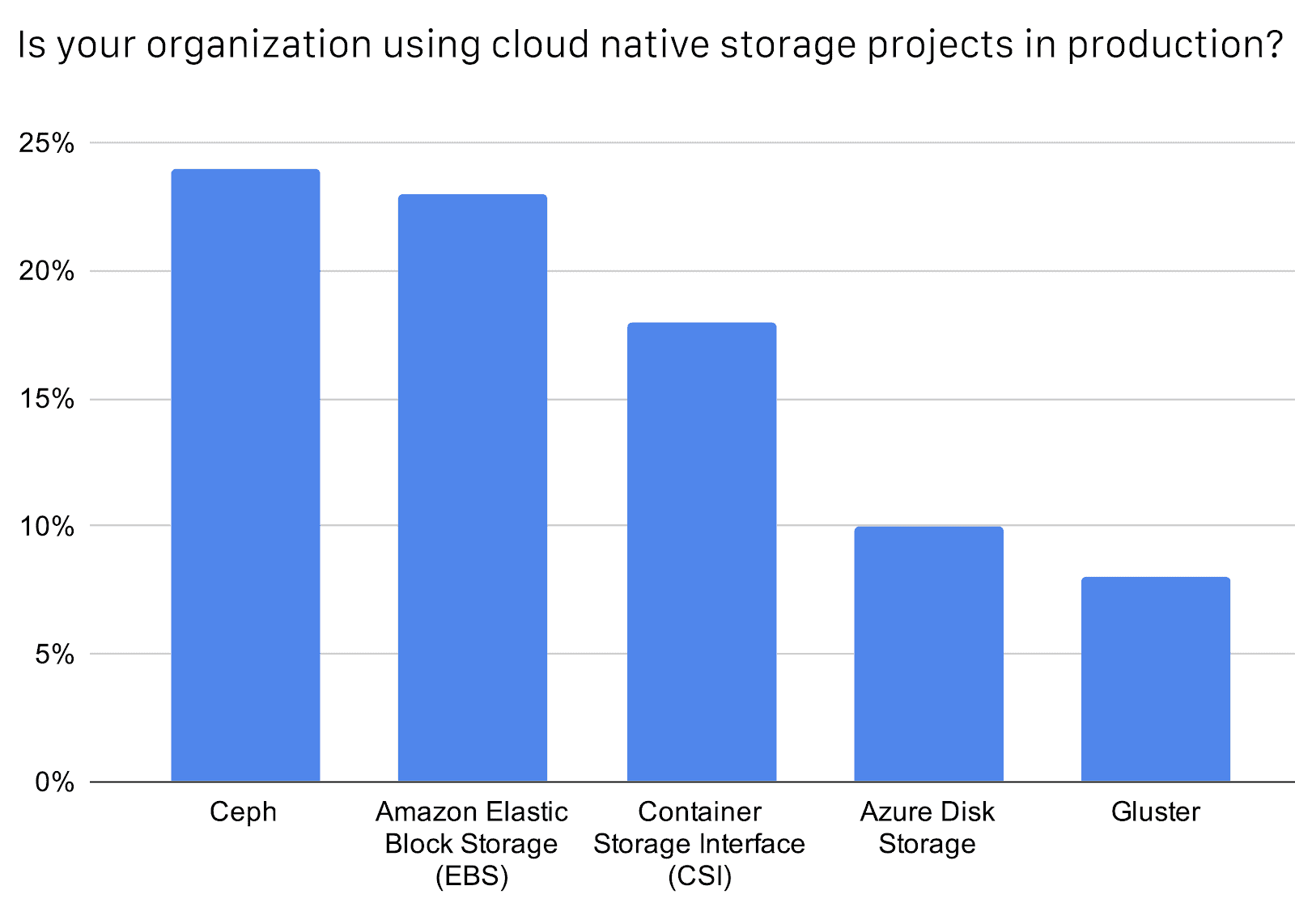
The most used cloud native storage projects are Ceph (24%), Amazon Elastic Block Storage (EBS) (23%) and Container Storage Interface (CSI) (18%)
最常用的云原生存储项目是Ceph(24%),Amazon Elastic Block Storage(EBS)(23%)和容器存储接口(CSI)(18%)
Service Mesh 服务网络
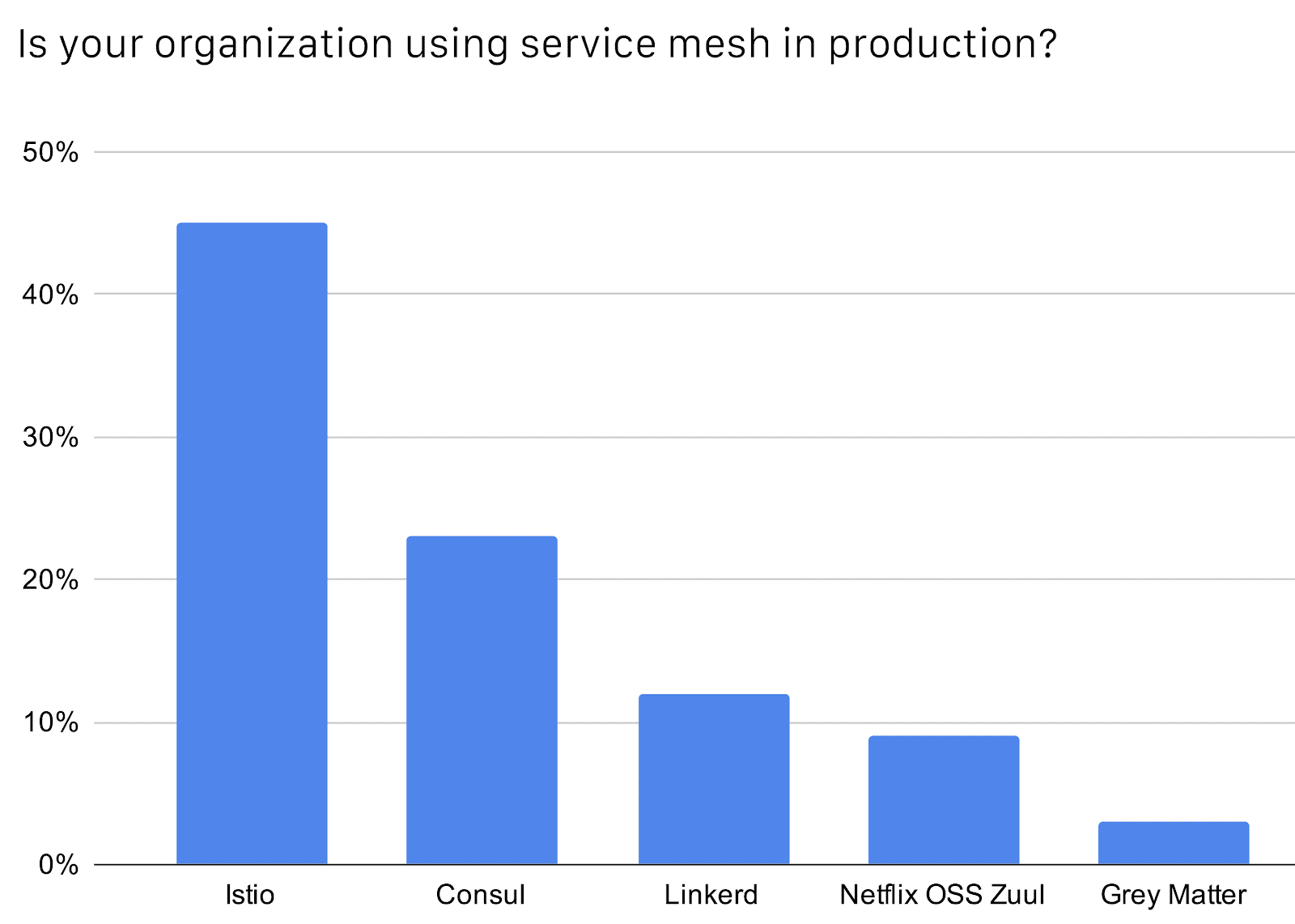
The Cloud Native Community in China
CNCF now has nearly 50 members in China. China is also the third-largest contributor to CNCF projects (in terms of contributors and committers) after the United States and Germany.
We have several case studies from China-based companies, including:
- JD.com, which saves approximately 60% of maintenance time for its private image central repository with Harbor.
- China Minsheng Bank, which has increased delivery efficiency by 3-4x, and doubled resource utilization with Kubernetes.
- Ant Financial, which has seen at least tenfold improvement in terms of the operations with cloud native technology.
We also launched a Kubernetes and Cloud Native course in China taken by 20,000+ people, and recently finished the first Cloud Native + Open Source Virtual Summit China.
The China community learns about cloud native technologies in many different ways.
中国云原生社区
CNCF现在在中国有近50个成员。 中国还是CNCF项目的第三大贡献者(按贡献者和提交者计),仅次于美国和德国。
我们有一些中国公司的案例研究,包括:
●京东使用Harbor为其私有图像中央存储器节省了大约60%的维护时间。
●中国民生银行交付效率提高了3-4倍,并且使用Kubernetes资源利用率翻了一番。
●蚂蚁金服使用云原生技术,运营方面至少提升十倍。
我们还在中国开设了20,000多人参加的Kubernetes and Cloud Native课程,最近还完成了首届中国 Cloud Native + Open Source虚拟峰会。
中国社区以多种不同方式了解云原生技术。
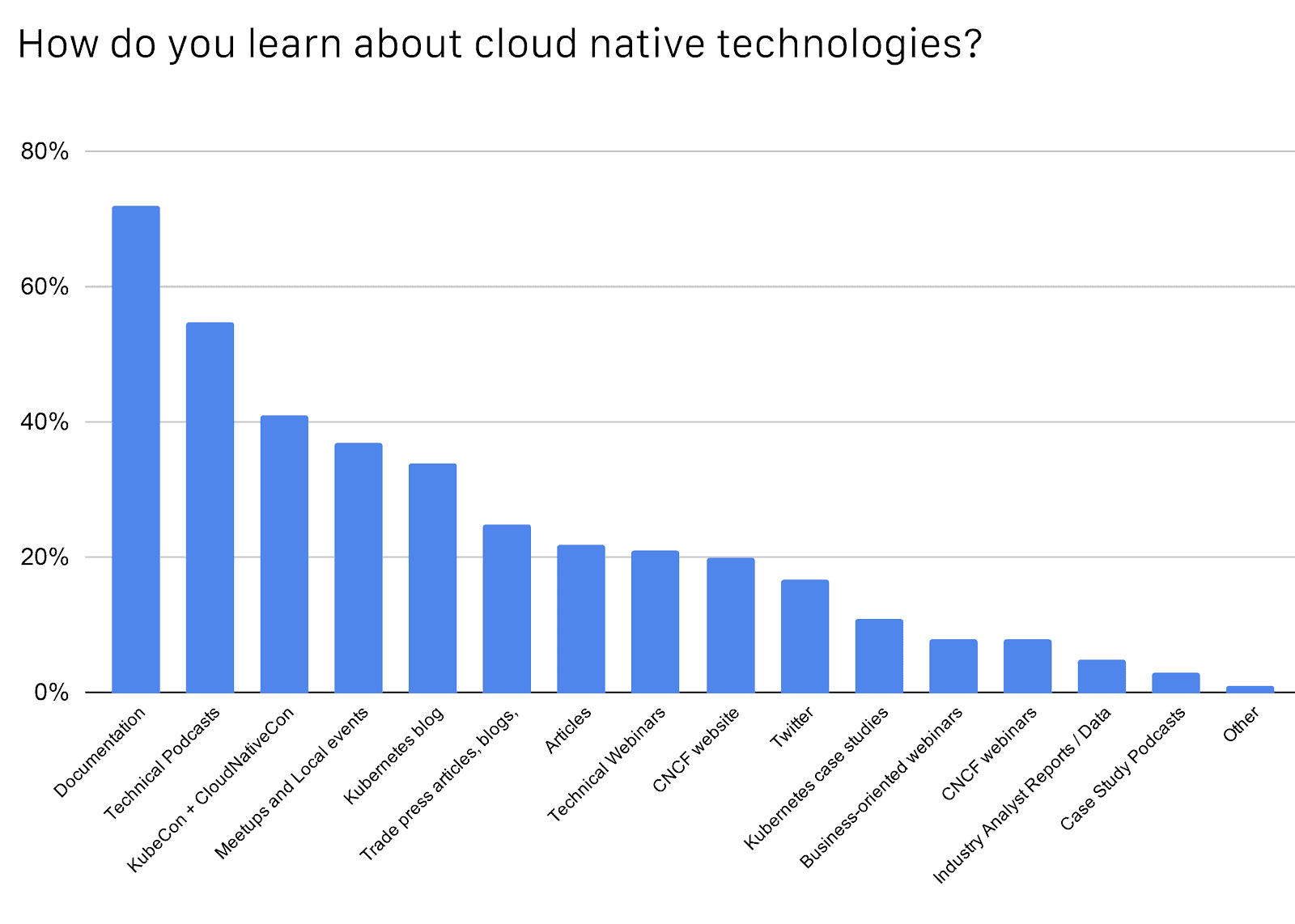
Documentation 文件
Technical podcast 技术播客
KubeCon+ CloudNativeCon
Meetups and local events聚会和本地活动
Kubernetes blog Kubernetes博客
Trade press articals, blogs行业刊物文章 ,博客
Articles文章
Technical Webinars 技术研讨会
CNCF website CNCF网站
Kubernetes case studies Kubernetes案例研究
Business-orientied webinars 业务导向的研讨会
CNCF webinars CNCF研讨会
Industry Analyst Reports/Data 行业分析报告/数据
Case Study Podcasts 案例研究播客
Other其他
Documentation
72% of China survey respondents learn about cloud native technologies through documentation. Each CNCF project hosts extensive documentation on their websites, which can be found here.
CNCF invests thousands of dollars per year in improving project documentation. This includes project documentation hosting, adding tutorials, how-to guides, and more.
文档
72%的中国受访者通过文档了解了云原生技术。 每个CNCF项目在其网站上都有大量文档,可在此处找到。
CNCF每年投资数千美元来改善项目文档。 其中包括项目文档托管,添加教程,操作指南等。
Events
Events are a popular way for respondents to learn about cloud native technologies.
41% of respondents selected KubeCon + CloudNativeCon as somewhere to learn about new technologies. The next virtual KubeCon + CloudNativeCon is scheduled for November 17-20.
Meetups and local events, like Cloud Native Community Groups, were selected by 37% of respondents as a way to learn about cloud native technologies.
活动
活动是受访者了解云原生技术的一种流行方式。
41%的受访者选择KubeCon + CloudNativeCon作为学习新技术的地方。 下一个虚拟KubeCon + CloudNativeCon计划于11月17日至20日举行。
37%的受访者选择了聚会和本地活动,(例如Cloud Native Community Groups)作为了解云原生技术的一种方式。
Webinars
22% of respondents learn about cloud native technologies through technical webinars, with another 8% selecting business-oriented webinars, and 8% selecting CNCF webinars.
CNCF has ramped up its webinar program, with regular webinars scheduled for Chinese audiences. You can see the upcoming schedule and view recordings, slides, and replays of previous webinars here.
网络研讨会
22%的受访者通过技术网络研讨会了解云原生技术,另有8%选择面向业务的网络研讨会,还有8%选择CNCF网络研讨会。
CNCF加强了其网络研讨会项目,并计划为中国观众安排定期的网络研讨会。 您可以在此处查看即将到来的日程安排及录像,幻灯片和之前网络研讨会的回放。
About the Survey Methodology & Respondents
A huge thank you to everyone who participated in this survey!
The survey was conducted in October 2019. It was conducted in Mandarin, with 97% of the 300 respondents coming from Asia.
关于调查方法和受访对象
非常感谢参与此调查的每个人!
该调查于2019年10月进行。该调查以中文进行,300名受访对象中97%来自亚洲。
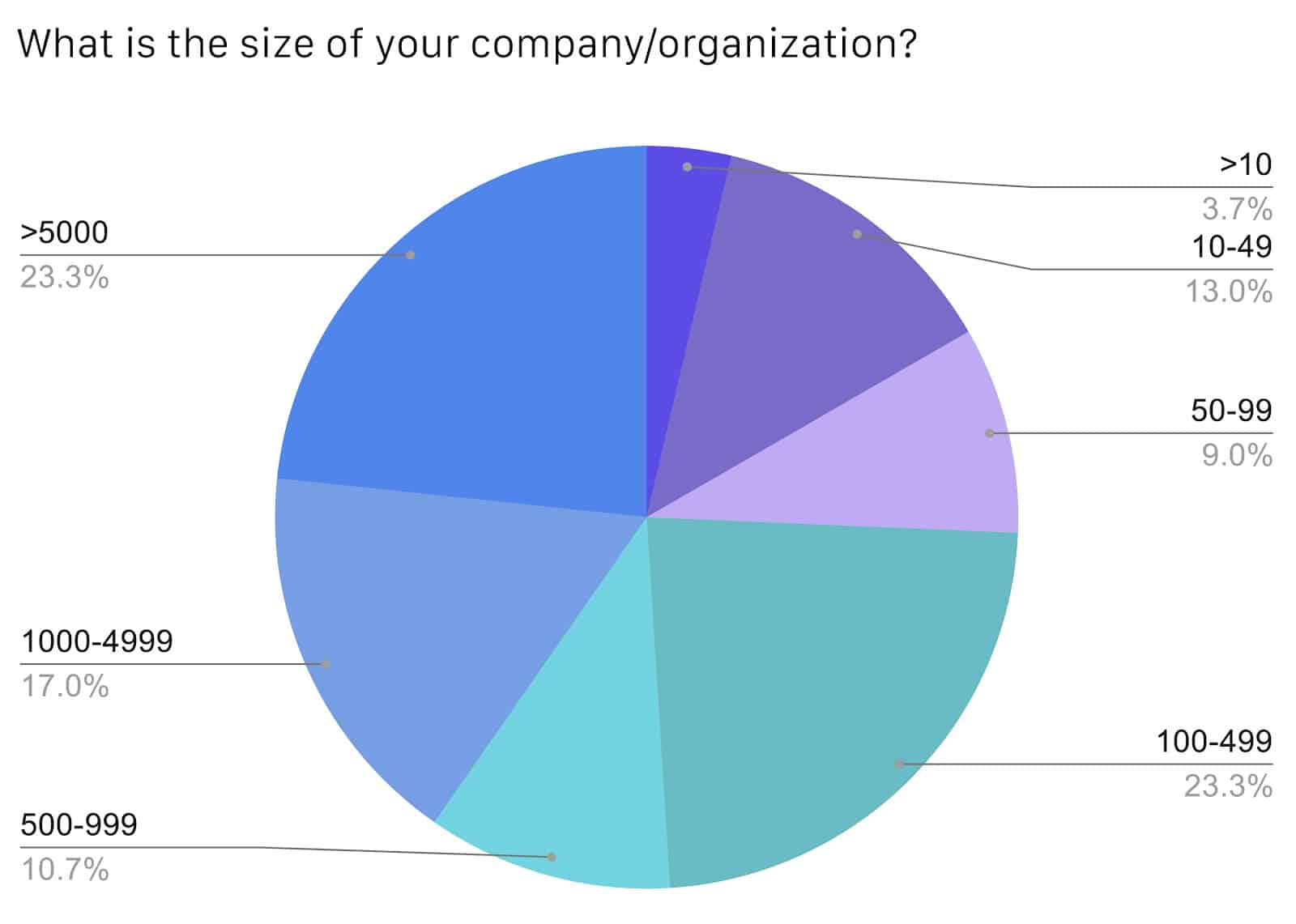
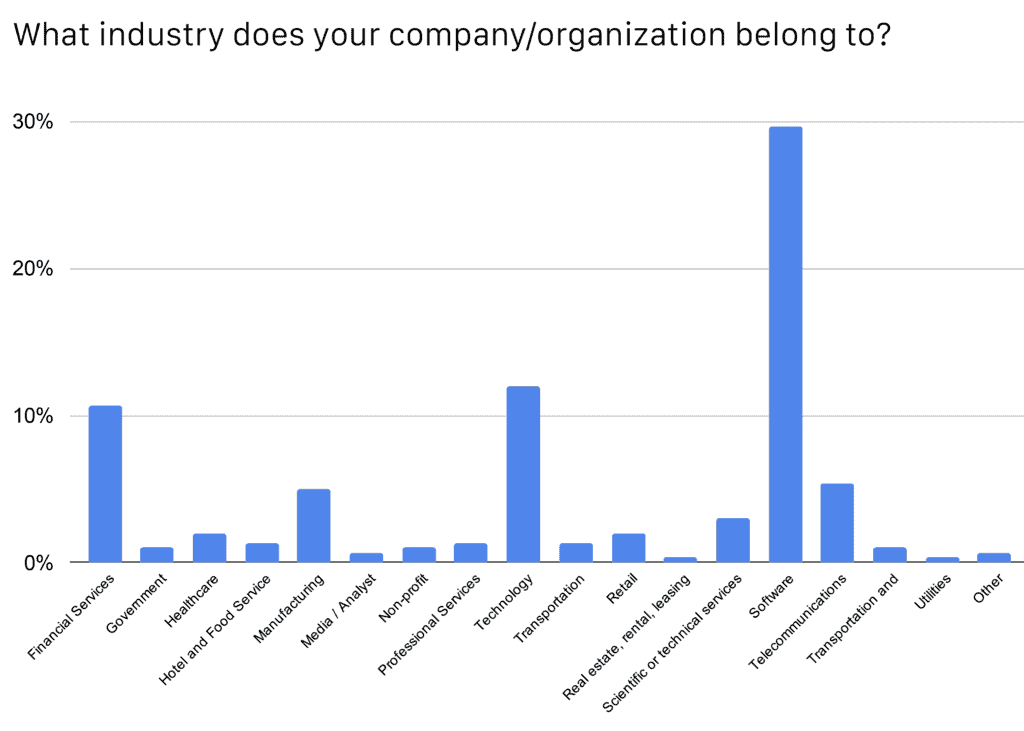
Financial services 金融服务
Government 政府
Healthcare医疗
Hotel and food services酒店和餐饮服务
Manufacturing制造
Media/Analyst媒体/分析
Non-profit非盈利
Professional services 专业服务
Technology技术
Transportation交通
Retail零售
Real estate, rental, leasing 房地产,租借,租赁
Scientific or technical services 科学技术服务
Software 软件
Telecommunications 通讯
Transportation and 交通和
Utilities 设备
Other 其他
